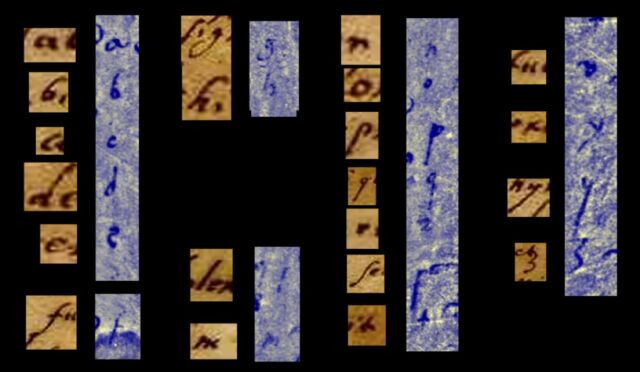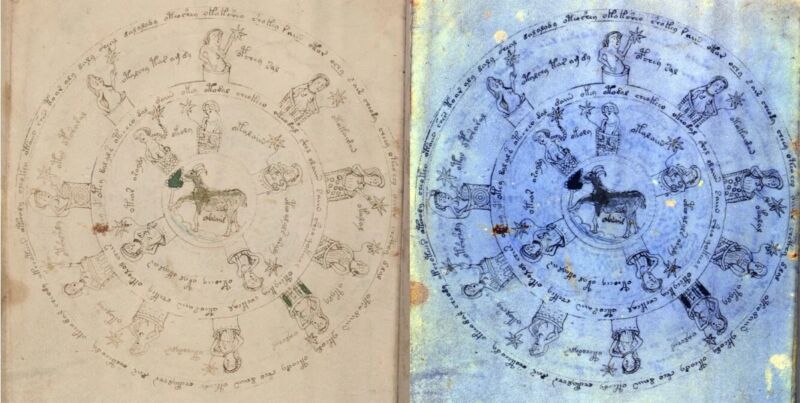When the manuscript first came into Wilfrid Voynich's hands in 1912, he noted that the first page had an effaced inscription in the lower margin, applying a chemical reagent to the page around 1914 to make it more visible. He thought he could make out a signature: "Jacobi à Tepenecz," aka an alchemist in Prague named Jacobus Sinapius, who probably owned the manuscript in the late 16th or early 17th century.
Fagin Davis's analysis confirmed Voynich's discovery. She also noted that there was no evidence that the Voynich manuscript is a palimpsest, i.e., parchment that had been reused and thus showed evidence of underwriting. That would have helped refine the manuscript's date of origin. Carbon-14 testing puts the date as around 1425, which Fagin Davis thinks is likely since the illustrations are consistent with that period, but some scholars disagree. Nor is the manuscript likely to be a modern forgery. Per Fagin Davis:
Imagine you are an early 20th-century forger trying to create an authentic-looking manuscript to dupe unsuspecting buyers (or so the argument goes). You find some unused medieval parchment, mix up some ink and pigments using medieval recipes, and get to work. You might even think to add an early-modern signature and annotations to the margins to add to the air of authenticity. But would you then fade those annotations (how would you manage that, anyway?), pour chemicals over them, and then hope that someday imaging technologies would develop that would allow future researchers to read them? Of course not. That line of reasoning defies both logic and practicality. It is much more likely that the manuscript is exactly what most believe it to be: an authentic early fifteenth-century book with traces of its history left behind by past owners and readers.
More recently, Voynich scholars had noted what seems to be a Roman alphabet written in the right-hand margin of that first page. Multispectral imaging clearly reveals the letters a, b, c, d, and e, according to Fagin Davis. In fact, there are actually three columns of lettering, not just one: the Roman alphabet, a series of Voynich characters, and another Roman alphabet, this time offset by one letter. Fagin Davis did her own preliminary transcription of those alphabets and concluded that this is mostly likely an early attempt to decode the manuscript. But who had made the attempt?

To find out, Fagin Davis combed through several letters written in the so-called "humanistic bookhand' commonly used by Petrarch and Boccaccio in 14th-century Italy, since the two Roman alphabet columns in the Voynich manuscript were also written in that style. She compared those handwriting samples with the columns in the Voynich manuscript.
One was a very close match: a September 12, 1640 letter to Athanasius Kircher written by Johannes Marcus Marci, a doctor in Prague who inherited the manuscript from his friend Georg Baresch when the alchemist died in 1662. Marci sent the manuscript to Kircher in Rome in 1665, hoping that the Jesuit scholar and polymath would be able to decipher it.
Fagin Davis identified several "strong markers" between the two handwriting samples that she thinks identify Marci as the would-be decoder. For instance, at this time in the 17th century, many people used prominent loops on the letters b, d, f, h, p, q, s, and y, but Marci did not. Not did the person who wrote the two Roman alphabet columns on that page of the Voynich manuscript. Marci also sometimes used an "open bowl" g, an m with a taller first stroke than the last, and a distinctive shape to his z's—all of which are consistent with the handwriting sample in the Voynich manuscript.
That said, anyone hoping this multispectral analysis of the scans will finally solve the mystery of the Voynich manuscript once and for all is bound to be disappointed, although any new textual evidence is significant for scholars.
"These alphabets will likely not help us actually decipher the manuscript," Fagin Davis wrote on her blog. "This is because linguists... and other researchers have established that the manuscript is almost certainly not encrypted using a simple substitution cipher, and the substitutions in these columns result in nonsense anyway. Even so, they do add an interesting and new chapter to the early history of the manuscript. I look forward to hearing from other researchers about this new evidence, especially from experts in cryptography who may have ideas about why Marci or any other early-modern decrypter would need three columns of alphabets to do their work."













Comments